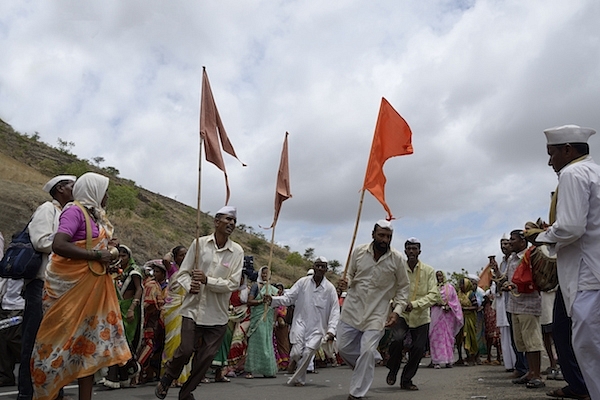Culture
Don’t Use Caste To Erase Indian Civilisation
- Social inequities have existed in all societies across the world regarding differences in class, race, gender and so on. India is no exception.
- Hinduism, since Vedic times, has evolved with contributions from diverse communities within.

The annual procession called ‘Wari’ in central-west India (June–July)
I was born in a Shudra community to a family of peasants in Western India.
When I was a child, I started going to our small farm where my family grew vegetables and fruits with utmost care. “Kanda, Mula, Bhaji, Avaghi Vithai Mazi,” my grandfather used to sing melodiously while farming. This abhang or a “sacred poem” was composed by a Hindu peasant saint named Savta Mali. It means, ‘there is divinity within everything, even plants and vegetables.’ The poem has left an everlasting imprint on my heart—to me, it encapsulates the most essential teachings of Hinduism from the time of the Vedas, in the simplest of terms.
Hinduism, since Vedic times, has evolved with contributions from diverse communities within. I feel proud that communities like the one I belong to have greatly contributed to Hinduism. It may be ancient Vedic sages such as Valmiki and Vyasa who were born into non-Brahmin families, or one of numerous later day spiritual figures such as Janabai, Ravidas, Sajan Kasai, Tukaram, Gora Kumbhar, Chokha Mela, and Nirmala Mahar—women and men who came from Dalit and “lower caste” communities like my own— who have helped Hinduism grow, rejuvenate and reform. They have been role models for Hindus of all social backgrounds. These are the kind of people that come to my mind when I think of Hinduism and its history.
Social inequities have existed in all societies across the world regarding differences in class, race, gender and so on. India is no exception. And as an advocate for social justice, I do not shy away from the need to question, fight, correct and overcome the social ills that have accrued in society over time due to stagnation, decay, invasions and colonialism. But the force to fight for social justice is not some gift given to us by the colonial British or the Western world. We have found the inspiration for our struggle within Hinduism and its traditions—from the Vedas that see divinity in all human beings, the Bhakti traditions which see no distinction of caste or class, the innumerable later day social reformer saints like Narayan Guru and Swami Vivekananda, who questioned social ills and helped reform Hindu society.
SAFG and its allies, while claiming to champion the cause of “lower castes” has not only failed to capture any of our contributions but has sought the erasure of whatever little exists about our heritage in the textbooks. For example, the group has callously advocated the removal of the mention in textbooks that great sages Vyasa and Valmiki were not born to Brahmin families. Take also the case where the Hindu community had requested that Sant Ravidas and Alvars be added as examples of Bhakti saints. Sant Ravidas came from the most underprivileged of backgrounds and went on to become one of the most admired spiritual leaders in Hinduism. This suggested inclusion was apparently rejected by the writing team of the Department of Education, as it “conflict[ed] with another submission”—that of the SAFG, which did not even care to mention any of such saints, preventing their spiritual teachings and contributions from being mentioned in the textbooks.
An impression is also being created that demanding a fair and equitable portrayal of Indian Civilisation and Hinduism in California school textbooks is unjust or runs contrary to the interests of underprivileged sections of the Indian society as if these communities are not Hindu or Indian! This view essentialises Hinduism into “Brahminism,” eliminates the contributions of diverse communities within Hinduism and forces these communities into conflict with their own civilisation.
In 1931, at the peak of British colonisation of India, Winston Churchill had argued that “To abandon India to the rule of the Brahmins would be an act of cruel and wicked negligence.” The British characterised the call for Indian Independence by Mahatma Gandhi and other leaders as merely a “Brahminical” concern, and presented themselves as saviours of the so called “lower castes”. This trademark “Divide and Rule” policy was used by colonialists to legitimise colonial rule while perpetrating the most gruesome of horrors on the very Indian people. It is indeed a tragic irony that similar arguments are being used today by the SAFG to justify the erasure of Indian civilisation, as well as the heritage and contributions of communities such as mine.
My children deserve to be told the truth about their ancestors, and not lies about them being mere nobodies and victims who did not contribute to the building of Indian Civilisation.
Hinduism and Indian Civilisation belongs to Dalits and “lower castes” as much as it belongs to any other community. In fact, it belongs to us even more. If you erase Indian Civilisation and Hinduism, you erase us too.
This article was originally published in The Huffington Post and has been republished here with permission.
Introducing ElectionsHQ + 50 Ground Reports Project
The 2024 elections might seem easy to guess, but there are some important questions that shouldn't be missed.
Do freebies still sway voters? Do people prioritise infrastructure when voting? How will Punjab vote?
The answers to these questions provide great insights into where we, as a country, are headed in the years to come.
Swarajya is starting a project with an aim to do 50 solid ground stories and a smart commentary service on WhatsApp, a one-of-a-kind. We'd love your support during this election season.
Click below to contribute.
Latest